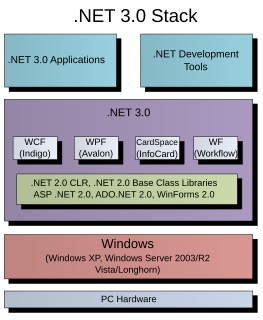The Organization for the Advancement of Structured Information Standards (OASIS) is a global nonprofit consortium that works on the development, convergence, and adoption of open standards for security, Internet of Things, energy, content technologies, emergency management, and other areas.
Web Services Security is an extension to SOAP to apply security to Web services. It is a member of the Web service specifications and was published by OASIS.
Web Services Discovery provides access to software systems over the Internet using standard protocols. In the most basic scenario there is a Web Service Provider that publishes a service and a Web Service Consumer that uses this service. Web Service Discovery is the process of finding suitable web services for a given task.
WS-Inspection is a Web service specification for "discovery documents" developed in a joint effort by Microsoft and IBM. WS-Inspection lists groups of web services and their endpoints in an XML format. Currently, other standards are being used for this purpose, such as Microsoft's DISCO. It is expected that WS-Inspection will eventually replace these standards to become the universally accepted discovery standard for Web services.
In computing, Web-Based Enterprise Management (WBEM) comprises a set of systems-management technologies developed to unify the management of distributed computing environments. The WBEM initiative, initially sponsored in 1996 by BMC Software, Cisco Systems, Compaq Computer, Intel, and Microsoft, is now widely adopted. WBEM is based on Internet standards and Distributed Management Task Force (DMTF) open standards:
Web Services Resource Framework (WSRF) is a family of OASIS-published specifications for web services. Major contributors include the Globus Alliance and IBM.

The Windows Communication Foundation (WCF), previously known as Indigo, is a runtime and a set of APIs in the .NET Framework for building connected, service-oriented applications.
An XML appliance is a special-purpose network device used to secure, manage and mediate XML traffic. They are most popularly implemented in service-oriented architectures (SOA) to control XML-based web services traffic, and increasingly in cloud-oriented computing to help enterprises integrate on premises applications with off-premises cloud-hosted applications. XML appliances are also commonly referred to as SOA appliances, SOA gateways, XML gateways, and cloud brokers. Some have also been deployed for more specific applications like Message-oriented middleware. While the originators of the product category deployed exclusively as hardware, today most XML appliances are also available as software gateways and virtual appliances for environments like VMWare.

Windows CardSpace, is Microsoft's now-canceled client software for the Identity Metasystem. CardSpace is an instance of a class of identity client software called an Identity Selector. CardSpace stores references to users' digital identities for them, presenting them to users as visual Information Cards. CardSpace provides a consistent UI designed to help people to easily and securely use these identities in applications and web sites where they are accepted. Resistance to phishing attacks and adherence to Kim Cameron's "7 Laws of Identity" were goals in its design.
The Devices Profile for Web Services (DPWS) defines a minimal set of implementation constraints to enable secure web service messaging, discovery, description, and eventing on resource-constrained devices.
Service-oriented architecture (SOA) allows different ways to develop applications by combining services. The main premise of SOA is to erase application boundaries and technology differences. As applications are opened up, how we can combine these services securely becomes an issue. Traditionally, security models have been hardcoded into applications and when capabilities of an application are opened up for use by other applications, the security models built into each application may not be good enough.

Apache Axis2 is a core engine for Web services. It is a complete re-design and re-write of the widely used Apache Axis SOAP stack. Implementations of Axis2 are available in Java and C.
Apache CXF is an open-source, fully featured Web services framework. It originated as the combination of two open-source projects: Celtix developed by IONA Technologies and XFire developed by a team hosted at Codehaus. These two projects were combined by people working together at the Apache Software Foundation and the new name CXF was derived by combining "Celtix" and "XFire".
WS-SecurityPolicy is a web services specification, created by IBM and 12 co-authors, that has become an OASIS standard as of version 1.2. It extends the fundamental security protocols specified by the WS-Security, WS-Trust and WS-SecureConversation by offering mechanisms to represent the capabilities and requirements of web services as policies. Security policy assertions are based on the WS-Policy framework.

Information cards are personal digital identities that people can use online, and the key component of an identity metasystem. Visually, each i-card has a card-shaped picture and a card name associated with it that enable people to organize their digital identities and to easily select one they want to use for any given interaction. The information card metaphor is implemented by identity selectors like Windows CardSpace, DigitalMe or Higgins Identity Selector.
Security token service (STS) is a cross-platform open standard core component of the OASIS group's WS-Trust web services single sign-on infrastructure framework specification.cf. Within that claims-based identity framework, a secure token service is responsible for issuing, validating, renewing and cancelling security tokens. The tokens issued by security token services can then be used to identify the holder of the token to services that adhere to the WS-Trust standard. Security token service provides the same functionality as OpenID, but unlike OpenID is not patent encumbered. Together with the rest of the WS-Trust standard, the security token service specification was initially developed by employees of IBM, Microsoft, Nortel and VeriSign.
Web Services Flow Language 1.0 (WSFL) was an XML programming language proposed by IBM in 2001 for describing Web services compositions. Language considered two types of compositions. The first type was for describing business processes as a collection of web services and the second was for describing interactions between partners. WSFL was proposed to be layered on top of Web Services Description Language.



